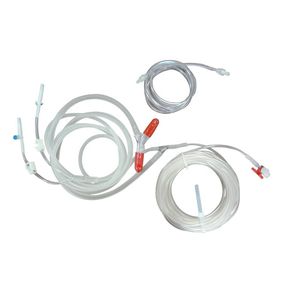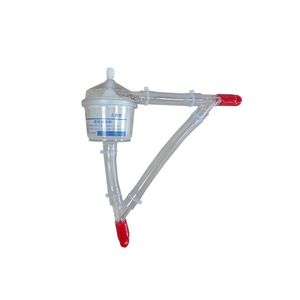
- Secondary care
- Cardiology
- Beijing iTrason Technologies
- Company
- Products
- Catalogs
- News & Trends
- Exhibitions
Adult extracorporeal oxygenator Membrane Oxygenator
Add to favorites
Compare this product
Characteristics
- Patient type
- adult
Description
A membrane oxygenator is a medical device used in extracorporeal membrane oxygenation (ECMO) and cardiopulmonary bypass (CPB) procedures to oxygenate and remove carbon dioxide from blood. It consists of a thin layer of gas-permeable membrane that separates the blood and gas flow within the device.
During ECMO or CPB, blood is diverted from the body to the oxygenator, where it flows on one side of the membrane. Oxygen is delivered to the blood through the membrane, while carbon dioxide is removed. The oxygenated blood is then returned to the body via a pump.
Membrane oxygenators are commonly used in critical care settings when a patient's lungs are unable to provide sufficient oxygenation or ventilation. They may be used as a temporary measure while a patient recovers from a respiratory illness or injury, or as a bridge to lung transplantation.
Catalogs
No catalogs are available for this product.
See all of Beijing iTrason Technologies‘s catalogsOther Beijing iTrason Technologies products
Autotransfusion System Accessories
Related Searches
- Ultrasound system
- B/W ultrasound system
- Color doppler ultrasound system
- Multipurpose ultrasound imaging system
- Portable ultrasound system
- Convex-array ultrasound system
- Linear-array ultrasound system
- On-platform ultrasound system
- Hand-held ultrasound system
- Touchscreen ultrasound system
- Wireless probe ultrasound system
- Spectral doppler ultrasound system
- 3D/4D ultrasound system
- Microconvex-array ultrasound system
- Phased-array ultrasound system
- Cardiovascular ultrasound imaging system
- Urology ultrasound imaging system
- Endocavitary ultrasound system
- Elastography ultrasound system
- Needle guidance ultrasound system
*Prices are pre-tax. They exclude delivery charges and customs duties and do not include additional charges for installation or activation options. Prices are indicative only and may vary by country, with changes to the cost of raw materials and exchange rates.







